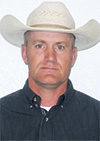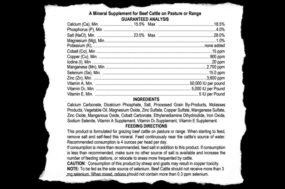All living creatures that we know of have biological ways of controlling what they reproduce. Chromosomes are collections of microscopic proteins that hold keys to what each cell does. They are very small rods that contain genes, which through a very powerful microscope look like strings of beads.
Genotype is what the animal should probably be like because of how its parents are – the pedigree, in other words. The phenotype is what that animal actually is or becomes. Phenotype is in large part determined by the quality of feed it is given, the climate, diseases it contracts, etc.
So genotype is what the pedigree says it should be, and phenotype is what it actually looks like.
The breeder of livestock wants to know how can he or she improve the progeny (calves) of the breeding stock. Here we are looking at traits such as skeletal measurements, birth weight, growth rate, etc. Some of these traits can be easily passed on to the progeny and some are not inherited as quickly.
Every offspring inherits one gene for each trait from its mother and one gene for that same trait from the father. In many genes, there is one that is dominant and controls what the offspring is going to be like in that gene (hair color, for instance), and one gene is recessive.
For the genes that control hair color, the dominant hair color gene gives a baby the color of its hair. If the genes are the same for that trait, hair color for instance, it is called homozygous, and when they are different it is called heterozygous.
Inbred or linebred
The old saying is, if the breeding worked, it is linebred. If it did not work, it is inbred. How can you know if a particular male of the species (bull, ram, stallion, etc.) will pass on a particular trait to its babies?
Fortunately, a number of breed organizations in cattle and sheep have determined this. In cattle, it is called EPD (expected progeny differences), and in sheep they call it EBV (estimated breeding values).
While there are some differences, EPDs and EBVs are the same as to what is looked for. But many ranchers misconstrue the terms and how they may apply to their cattle or sheep.
Many times I have heard ranchers talk about buying a particular bull because his EPDs are good for low birthweight, for instance. It may be a Hereford bull they are talking about, but they want to breed that Hereford to their Charolais cows.
EPDs are comparing Hereford bulls to other Hereford bulls or comparing Santa Gertrudis bulls to other Santa Gertrudis bulls. EPDs do not compare Hereford bulls to Charolais cows, or even Charolais bulls.
EPDs measure the difference in how one particular bull produces a particular trait when compared with other bulls of the very same breed. The EPD will be either a positive number or negative number. That is showing how that particular bull’s calves relate to the average of calves of other bulls of the very same breed.
A plus number means that particular bull does better for that trait than other bulls of the same breed.
To further complicate the issue, it is comparing one bull with other bulls of the same breed involved in the same test. Some breeds have an extensive number of bulls involved in their studies, so the EPD of a particular breed might be more accurate than EPDs from other breeds with fewer bulls involved in their tests.
For sheep, EBVs are calculated on the performance of the individual animal, related animals in the same flock and related animals in other flocks.
The National Sheep Improvement Program has grouped certain EBV traits together in order to create indexes that are particularly useful tools for selecting breeding stock suited to a particular situation. This is more accurate as areas can differ due to climate, vegetation, etc.
Hybrid vigor
Some traits are more highly heritable (such as carcass type, skeletal measurements, mature weight, etc.), some are of medium heritability (birthweight, weaning weight, yearling weight, milk production and growth rate) and others are difficult to pass on to progeny (maternal ability, reproduction rate, health, longevity, productivity, etc.).
Breeding one animal with a highly desirable trait to another animal weaker in that same trait is a time-honored way of improving your herd. Does this always mean the resulting baby will have the stronger trait? Not necessarily, as it depends on the trait.
For those highly heritable traits (mature weight, for instance), the resulting baby will probably be stronger in that trait than the weaker parent. This is called hybrid vigor. But in those less heritable traits (reproduction rate, etc.), you might not see a drastic improvement.
To improve those less heritable traits, you need to repeatedly breed a parent with the strong trait to the resulting baby for successive generations, with each new calf generally being an improvement over its parent. For the more heritable traits, you should be able to accomplish much in the first generation with the hybrid vigor.
While EPDs are an important tool for your breeding program, make sure you are comparing apples to apples when you select a bull for its EPDs. Breed with your ultimate goal in mind and not just because someone tells you the bull’s numbers are “good.” ![]()
Les Nunn is a retired professor and graduate of the King Ranch Institute of Ranch Management, Texas A&M. He ranches in Oklahoma and does agricultural business plan consulting.
Les Nunn is a freelance author. Email Les Nunn.







